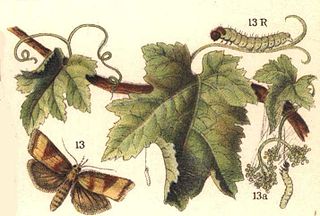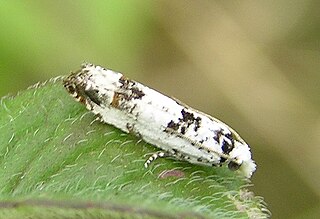Related Research Articles

The Tortricidae are a family of moths, commonly known as tortrix moths or leafroller moths, in the order Lepidoptera. This large family has over 11,000 species described, and is the sole member of the superfamily Tortricoidea, although the genus Heliocosma is sometimes placed within this superfamily. Many of these are economically important pests. Olethreutidae is a junior synonym. The typical resting posture is with the wings folded back, producing a rather rounded profile.

The Tortricinae are the nominate subfamily of tortrix moths. Commonly referred to as leafrollers, as the larvae build shelters by folding or rolling leaves of the food plant, the tortricinae include several notable pests as well species used as biological control agents against invasive weeds.

The Sparganothini are a tribe of tortrix moths.

The Archipini are a tribe of tortrix moths. Since many genera of these are not yet assigned to tribes, the genus list presented here is provisional.

Chlidanotinae is a subfamily of moths in the family Tortricidae.

The Cochylini are a tribe of tortrix moths. It used to be classified as the subfamily Cochylinae.

Eucosma is a very large genus of moths belonging to the family Tortricidae. Some taxonomies place a number of species in the genus Eucopina. The genus has a Holarctic and Indomalayan distribution. Even in well-studied Europe and North America, new species are still regularly discovered. There are at least 670 described species in Eucosma worldwide.

Eugnosta is a genus of moths belonging to the family Tortricidae.
Spinipogon is a genus of moths belonging to the family Tortricidae.

The Euliini are a tribe of tortrix moths.
Alexey Nikolaievich Diakonoff, also transliterated as Alexej Nikolajewitsch Diakonoff, was a Russian–Dutch entomologist who specialised in Microlepidoptera.
Spinipogon atrox is a species of moth of the family Tortricidae. It is found in Brazil in the states of Paraná and Minas Gerais.
Spinipogon trivius is a species of moth of the family Tortricidae. It is found in Paraná, Brazil.
Spinipogon resthavenensis is a species of moth of the family Tortricidae. It is found in North America, where it has been recorded from Ontario and Ohio to Florida and Texas. The habitat consists of tallgrass prairies.
Spinipogon virginanus is a species of moth of the family Tortricidae. It is found on the British Virgin Islands.
Spinipogon thes is a species of moth of the family Tortricidae. It is found in Brazil in the states of Minas Gerais and Santa Catarina.
Spinipogon spiniferus is a species of moth of the family Tortricidae. It is found in Brazil.
Spinipogon ialtris is a species of moth of the family Tortricidae. It is found in Veracruz, Mexico.
Spinipogon signata is a species of moth of the family Tortricidae. It is found in Argentina.
Spinipogon luxuria is a species of moth of the family Tortricidae. It is found in Peru.
References
- ↑ tortricidae.com
- ↑ Razowski,J. & V.O. Becker, 2002: Systematic and faunistic data on Neotropical Cochylini (Lepidoptera: Tortricidae), with descriptions of new species. Part.1. Acta zool. cracov.45: 287-316